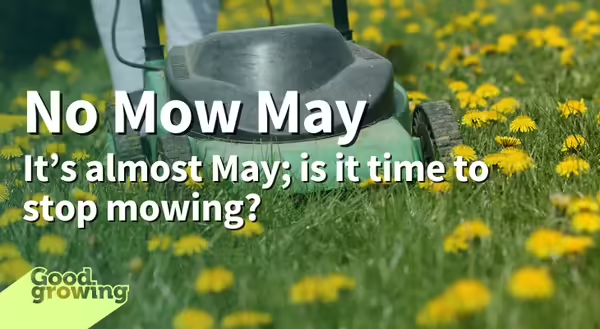
Did you notice people’s lawns getting a little long last May? No Mow May has become a popular way to help pollinators.
No Mow May began in the United Kingdom in 2019 as a way to help struggling pollinator populations. The idea is that if people don’t mow their lawns during May, it will allow ‘weeds’ to bloom. These flowers can then serve as a food source for pollinators when there aren’t many other things blooming in the landscape. While No Mow May might sound good in theory, it isn’t without its problems.
The drawbacks of No Mow May
While not mowing in May might be best for the United Kingdom, that isn’t necessarily the case for Illinois. Dandelions and clover are common blooming ‘weeds’ we see in many lawns. In many places in Illinois, peak dandelion bloom is in April, and peak clover bloom is in late May or June, so they will provide few resources for pollinators during No Mow May.
In most of Illinois, we are growing cool-season grasses, which are actively growing during the spring. If left unmown for an entire month during their peak growth time, they can reach 12+ inches tall. If lawns are then mowed to the recommended height of 3 inches at once, this can stress the plants right before we go into the hot summer months, which will make it more difficult for them to survive. To avoid stressing plants, no more than one-third of the grass leaf should be removed in a single cutting. If this is done, it could take quite a while to get a lawn down to 3 inches.
Allowing your yard to ‘go wild’ for a month to let weeds bloom (assuming you have weeds in your lawn) can be attractive to pollinators and other wildlife. However, what happens when everything is mowed, and all their food and habitat suddenly disappear? If there are no other flowers for the pollinators to visit, we’ve only provided a temporary solution.
A more sustainable approach to helping pollinators
Instead of neglecting our lawns for an entire month and then going back to business as usual, we can try mowing less frequently (the lazy lawn care approach). A study in Massachusetts found that lawns mowed every two weeks had more bees present than those mowed every week. Lawns that were mowed every three weeks had more flowers but fewer bees, possibly because the taller grass made it more difficult for bees to access the flowers.
While often maligned, lawns can serve important functions in our landscapes. They can help reduce erosion, increase water infiltration and help cool the air during summer. From places to entertain guests to somewhere to let the kids and dog run around, lawns also play an important role in recreation (functional lawn space). However, we all likely have some areas of our lawns that we never use, so-called non-functional lawns.
Consider converting some of this non-functional lawn space into pollinator habitat. Planting a diversity of flowering plants with different bloom times, colors, and shapes will help attract the widest range of pollinators. In addition to food, pollinators may also need areas to nest (bees), food sources for their young (such as host plants for caterpillars), and somewhere to overwinter. Also, don’t be in too big of a hurry to tidy up your landscape in the Spring.
Good Growing Fact of the Week: One of the papers most commonly pointed to for the benefits of No Mow May was retracted in 2022 due to inconsistencies. This doesn’t necessarily mean No Mow May doesn’t provide any benefit, but more research is needed.
Resources and for more information
Lerman, Susannah B., Alexandra R. Contosta, Joan Milam, and Christofer Bang. 2018. “To Mow or to Mow Less: Lawn Mowing Frequency Affects Bee Abundance and Diversity in Suburban Yards.” Biological Conservation 221 (221): 160–74. https://doi.org/10.1016/j.biocon.2018.01.025.
Portman, Zach. 2022. “Documenting Serious Issues in a Bee Paper on ‘No Mow May.’” Medium. November 21, 2022. https://zportman.medium.com/documenting-serious-issues-in-a-bee-paper-on-no-mow-may-dd9b563feac0.
Want to get notified when new Good Growing posts are available? SIGN ME UP!
Give us feedback! How helpful was this information (click one): Very helpful | Somewhat helpful | Not very helpful
MEET THE AUTHOR
Ken Johnson is a Horticulture Educator with University of Illinois Extension, serving Calhoun, Cass, Greene, Morgan, and Scott counties since 2013. Ken provides horticulture programming with an emphasis on fruit and vegetable production, pest management, and beneficial insects. Through his programming, he aims to increase backyard food production and foster a greater appreciation of insects.